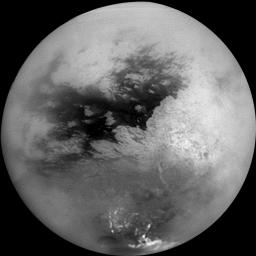Hovering Over Titan
Caption:
A mosaic of nine processed images recently acquired during Cassini's first very close flyby of Saturn's moon Titan on Oct. 26, 2004, constitutes the most detailed full-disc view of the mysterious moon.
The view is centered on 15 degrees South latitude, and 156 degrees West longitude. Brightness variations across the surface and bright clouds near the south pole are easily seen.
The images that comprise the mosaic have been processed to reduce the effects of the atmosphere and to sharpen surface features. The mosaic has been trimmed to show only the illuminated surface and not the atmosphere above the edge of the moon. The Sun was behind Cassini so nearly the full disc is illuminated. Pixels scales of the composite images vary from 2 to 4 kilometers per pixel (1.2 to 2.5 miles per pixel).
Surface features are best seen near the center of the disc, where the spacecraft is looking directly downwards; the contrast becomes progressively lower and surface features become fuzzier towards the outside, where the spacecraft is peering through haze, a circumstance that washes out surface features.
The brighter region on the right side and equatorial region is named Xanadu Regio. Scientists are actively debating what processes may have created the bizarre surface brightness patterns seen here. The images hint at a young surface with, no obvious craters. However, the exact nature of that activity, whether tectonic, wind-blown, fluvial, marine, or volcanic is still to be determined.
The images comprising this mosaic were acquired from distances ranging from 650,000 kilometers (400,000 miles) to 300,000 kilometers (200,000 miles).
Background Info:
The Cassini-Huygens mission is a cooperative project of NASA, the European Space Agency and the Italian Space Agency. The Jet Propulsion Laboratory, a division of the California Institute of Technology in Pasadena, manages the Cassini-Huygens mission for NASA's Office of Space Science, Washington, D.C. The Cassini orbiter and its two onboard cameras, were designed, developed and assembled at JPL. The imaging team is based at the Space Science Institute, Boulder, Colo.
For more information, about the Cassini-Huygens mission visit,
http://saturn.jpl.nasa.gov
and the Cassini imaging team home page,
http://ciclops.org
.
Cataloging Keywords:
| Name |
Value |
Additional Values |
| Target |
Titan |
|
| System |
Saturn |
|
| Target Type |
Satellite |
|
| Mission |
Cassini-Huygens |
|
| Instrument Host |
Cassini Orbiter |
|
| Host Type |
Orbiter |
|
| Instrument |
Imaging Science Subsystem (ISS) |
|
| Detector |
|
|
| Extra Keywords |
Atmosphere, Crater, Grayscale, Haze, Volcano |
| Acquisition Date |
|
| Release Date |
2004-11-23 |
| Date in Caption |
2004-10-26 |
|
| Image Credit |
NASA/JPL/Space Science Institute |
| Source |
photojournal.jpl.nasa.gov/catalog/PIA06141 |
| Identifier |
PIA06141 |

 Planetary Data System
Planetary Data System
